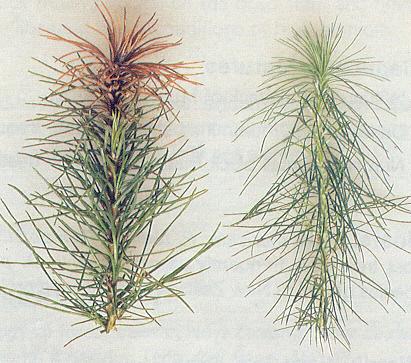PESTS AND DISEASES OF FORESTRY IN NEW ZEALAND
Bacterial dieback - nursery disease
From Forest Pathology in New Zealand No. 16. Nursery diseases.
Based on Margaret Dick and AL Vanner (1986),
Revised by MA Dick (2008).
Causal organism
Pseudomonas syringae p.v. syringae van Hall.
Type of injury
The stem of diseased seedlings is killed above the point of infection.
Diagnostic features
- Wilting and death of stem above the point of infection, which is usually near the apex (Fig. 5).
- Affected stem often purplish.
- Affected stem dries out, becoming brown and brittle.
Hosts
Pinus muricata, P. patula, P. radiata.
Distribution
The disease has been recorded in many nurseries between Hamilton and lnvercargill.
Disease development
The disease appears in autumn, generally when frosts follow a period of rain. A translucent lesion appears on the stem at the point of infection, usually in the soft regions of the stem near the terminal. The stem may become purplish as it wilts above the point of infection. The collapsed tissue then dies, becoming brown and brittle. If seedlings are left to grow on as 2/0 stock, either one lateral bud will develop into a dominant leader or several will develop into multi-leaders.

Fig. 5 – Pinus radiata seedlings with apical portion killed by Pseudomonas syringae on left. Healthy seedling on right.
Economic importance
Bacterial dieback is of little economic importance as it usually occurs in small isolated patches. However, one instance has been reported where over 20% of seedlings in a 0.8-ha block were affected by the disease.
Control
Control is not usually necessary as the disease occurs rarely, and usually in isolated patches. Antibiotic preparations containing streptomycin that were used in the past are no longer available but applications of copper products (350-500 gm a.i. copper hydroxide or copper oxychloride in 500 litres of water per hectare) have been demonstrated to reduce disease incidence.
Bibliography
Langridge, Y.N.; Dye, D.W. 1982: A bacterial disease of Pinus radiata seedlings caused by Pseudomonas syringae. New Zealand Journal of Agricultural Research 25: 273-276.

 Farm Forestry New Zealand
Farm Forestry New Zealand

